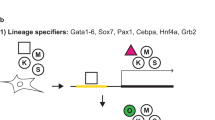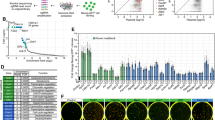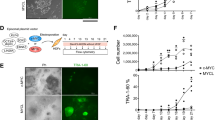Abstract
NANOG is a key transcription factor for pluripotency in embryonic stem cells. The analysis of NANOG in human cells is confounded by the presence of multiple and highly similar paralogs. In particular, there are three paralogs encoding full-length proteins, namely, NANOG1, NANOG2 and NANOGP8, and at least eight additional paralogs that do not encode full-length NANOG proteins. Here, we have examined NANOG family expression in human embryonic stem cells (hESCs) and in human cancer cell lines using a multi-NANOG PCR that amplifies the three functional paralogs and most of the non-functional ones. As anticipated, we found that hESCs express large amounts of NANOG1 and, interestingly, they also express NANOG2. In contrast, most human cancer cells tested express NANOGP8 and the non-coding paralogs NANOGP4 and NANOGP5. Notably, in some cancer cell lines, the NANOG protein levels produced by NANOGP8 are comparable to those produced by NANOG1 in pluripotent cells. Finally, we show that NANOGP8 is as active as NANOG1 in the reprogramming of human and murine fibroblasts into induced pluripotent stem cells. These results show that cancer-associated NANOGP8 can contribute to promote de-differentiation and/or cellular plasticity.
This is a preview of subscription content, access via your institution
Access options
Subscribe to this journal
Receive 50 print issues and online access
$259.00 per year
only $5.18 per issue
Buy this article
- Purchase on Springer Link
- Instant access to full article PDF
Prices may be subject to local taxes which are calculated during checkout



Similar content being viewed by others
References
Chambers I, Tomlinson SR . The transcriptional foundation of pluripotency. Development 2009; 136: 2311–2322.
Silva J, Nichols J, Theunissen TW, Guo G, van Oosten AL, Barrandon O et al. Nanog is the gateway to the pluripotent ground state. Cell 2009; 138: 722–737.
Booth HA, Holland PW . Eleven daughters of NANOG. Genomics 2004; 84: 229–238.
Chambers I, Colby D, Robertson M, Nichols J, Lee S, Tweedie S et al. Functional expression cloning of Nanog, a pluripotency sustaining factor in embryonic stem cells. Cell 2003; 113: 643–655.
Mitsui K, Tokuzawa Y, Itoh H, Segawa K, Murakami M, Takahashi K et al. The homeoprotein Nanog is required for maintenance of pluripotency in mouse epiblast and ES cells. Cell 2003; 113: 631–642.
Wang SH, Tsai MS, Chiang MF, Li H . A novel NK-type homeobox gene, ENK (early embryo specific NK), preferentially expressed in embryonic stem cells. Gene Expr Patterns 2003; 3: 99–103.
Yu J, Vodyanik MA, Smuga-Otto K, Antosiewicz-Bourget J, Frane JL, Tian S et al. Induced pluripotent stem cell lines derived from human somatic cells. Science 2007; 318: 1917–1920.
Hanna J, Saha K, Pando B, van Zon J, Lengner CJ, Creyghton MP et al. Direct cell reprogramming is a stochastic process amenable to acceleration. Nature 2009; 462: 595–601.
Theunissen TW, Costa Y, Radzisheuskaya A, van Oosten AL, Lavial F, Pain B et al. Reprogramming capacity of Nanog is functionally conserved in vertebrates and resides in a unique homeodomain. Development 2011; 138: 4853–4865.
Eberle I, Pless B, Braun M, Dingermann T, Marschalek R . Transcriptional properties of human NANOG1 and NANOG2 in acute leukemic cells. Nucleic Acids Res 2010; 38: 5384–5395.
Zbinden M, Duquet A, Lorente-Trigos A, Ngwabyt SN, Borges I, Ruiz i et al. NANOG regulates glioma stem cells and is essential in vivo acting in a cross-functional network with GLI1 and p53. EMBO J 2010; 29: 2659–2674.
Chang DF, Tsai SC, Wang XC, Xia P, Senadheera D, Lutzko C . Molecular characterization of the human NANOG protein. Stem Cells 2009; 27: 812–821.
Pan G, Pei D . The stem cell pluripotency factor NANOG activates transcription with two unusually potent subdomains at its C terminus. J Biol Chem 2005; 280: 1401–1407.
Do HJ, Lee WY, Lim HY, Oh JH, Kim DK, Kim JH et al. Two potent transactivation domains in the C-terminal region of human NANOG mediate transcriptional activation in human embryonic carcinoma cells. J Cell Biochem 2009; 106: 1079–1089.
Ambady S, Malcuit C, Kashpur O, Kole D, Holmes WF, Hedblom E et al. Expression of NANOG and NANOGP8 in a variety of undifferentiated and differentiated human cells. Int J Dev Biol 2010; 54: 1743–1754.
Ishiguro T, Sato A, Ohata H, Sakai H, Nakagama H, Okamoto K . Differential expression of nanog1 and nanogp8 in colon cancer cells. Biochem Biophys Res Commun 2012; 418: 199–204.
Jeter CR, Badeaux M, Choy G, Chandra D, Patrawala L, Liu C et al. Functional evidence that the self-renewal gene NANOG regulates human tumor development. Stem Cells 2009; 27: 993–1005.
Jeter CR, Liu B, Liu X, Chen X, Liu C, Calhoun-Davis T et al. NANOG promotes cancer stem cell characteristics and prostate cancer resistance to androgen deprivation. Oncogene 2011; 30: 3833–3845.
Zhang J, Wang X, Li M, Han J, Chen B, Wang B et al. NANOGP8 is a retrogene expressed in cancers. FEBS J 2006; 273: 1723–1730.
Zhang J, Espinoza LA, Kinders RJ, Lawrence SM, Pfister TD, Zhou M et al. NANOG modulates stemness in human colorectal cancer. Oncogene 2013; 32: 4397–4405.
Uchino K, Hirano G, Hirahashi M, Isobe T, Shirakawa T, Kusaba H et al. Human Nanog pseudogene8 promotes the proliferation of gastrointestinal cancer cells. Exp Cell Res 2012; 318: 1799–1807.
Zhang J, Wang X, Chen B, Xiao Z, Li W, Lu Y et al. The human pluripotency gene NANOG/NANOGP8 is expressed in gastric cancer and associated with tumor development. Oncol Lett 2010; 1: 457–463.
Suva ML, Riggi N, Bernstein BE . Epigenetic reprogramming in cancer. Science 2013; 339: 1567–1570.
Kim JS, Kim J, Kim BS, Chung HY, Lee YY, Park CS et al. Identification and functional characterization of an alternative splice variant within the fourth exon of human nanog. Exp Mol Med 2005; 37: 601–607.
Ying QL, Wray J, Nichols J, Batlle-Morera L, Doble B, Woodgett J et al. The ground state of embryonic stem cell self-renewal. Nature 2008; 453: 519–523.
Silva J, Barrandon O, Nichols J, Kawaguchi J, Theunissen TW, Smith A . Promotion of reprogramming to ground state pluripotency by signal inhibition. PLoS Biol 2008; 6: e253.
Moretto-Zita M, Jin H, Shen Z, Zhao T, Briggs SP, Xu Y . Phosphorylation stabilizes Nanog by promoting its interaction with Pin1. Proc Natl Acad Sci USA 2010; 107: 13312–13317.
Ramakrishna S, Suresh B, Lim KH, Cha BH, Lee SH, Kim KS et al. PEST motif sequence regulating human NANOG for proteasomal degradation. Stem Cells Dev 2011; 20: 1511–1519.
Fujita J, Crane AM, Souza MK, Dejosez M, Kyba M, Flavell RA et al. Caspase activity mediates the differentiation of embryonic stem cells. Cell Stem Cell 2008; 2: 595–601.
Grigoriadis AE, Kennedy M, Bozec A, Brunton F, Stenbeck G, Park IH et al. Directed differentiation of hematopoietic precursors and functional osteoclasts from human ES and iPS cells. Blood 2010; 115: 2769–2776.
Lowry WE, Richter L, Yachechko R, Pyle AD, Tchieu J, Sridharan R et al. Generation of human induced pluripotent stem cells from dermal fibroblasts. Proc Natl Acad Sci USA 2008; 105: 2883–2888.
Carey BW, Markoulaki S, Hanna J, Saha K, Gao Q, Mitalipova M et al. Reprogramming of murine and human somatic cells using a single polycistronic vector. Proc Natl Acad Sci USA 2009; 106: 157–162.
Hochedlinger K, Yamada Y, Beard C, Jaenisch R . Ectopic expression of Oct-4 blocks progenitor-cell differentiation and causes dysplasia in epithelial tissues. Cell 2005; 121: 465–477.
Takahashi K, Yamanaka S . Induction of pluripotent stem cells from mouse embryonic and adult fibroblast cultures by defined factors. Cell 2006; 126: 663–676.
Takahashi K, Tanabe K, Ohnuki M, Narita M, Ichisaka T, Tomoda K et al. Induction of pluripotent stem cells from adult human fibroblasts by defined factors. Cell 2007; 131: 861–872.
Acknowledgements
We are grateful to Dr Maria S Soengas (CNIO) for providing us with human primary fibroblasts and to Dr Miguel A Piris (CNIO) for providing us with all the human cancer cell lines. ARP is supported by the FPI Program of the Spanish Department of Science (MINECO). DP was funded by an EMBO Long-Term Fellowship. HL is supported by the ‘Ramon y Cajal’ Program (MINECO). Work in the laboratory of MS is funded by the CNIO and by grants from the MINECO (SAF), the European Union (ERC Advanced Grant), the Regional Government of Madrid, the Botin Foundation, the Ramon Areces Foundation and the AXA Foundation. Work in the laboratory of EFW is supported by grants from F-BBVA and the European Union (ERC Advanced Grant).
Author information
Authors and Affiliations
Corresponding author
Ethics declarations
Competing interests
The authors declare no conflict of interest.
Additional information
Supplementary Information accompanies this paper on the Oncogene website
Supplementary information
Rights and permissions
About this article
Cite this article
Palla, A., Piazzolla, D., Abad, M. et al. Reprogramming activity of NANOGP8, a NANOG family member widely expressed in cancer. Oncogene 33, 2513–2519 (2014). https://doi.org/10.1038/onc.2013.196
Received:
Revised:
Accepted:
Published:
Issue Date:
DOI: https://doi.org/10.1038/onc.2013.196
Keywords
This article is cited by
-
Pseudogene MAPK6P4-encoded functional peptide promotes glioblastoma vasculogenic mimicry development
Communications Biology (2023)
-
Insights into homeobox B9: a propeller for metastasis in dormant prostate cancer progenitor cells
British Journal of Cancer (2021)
-
Discovery of coding regions in the human genome by integrated proteogenomics analysis workflow
Nature Communications (2018)
-
NANOG reprograms prostate cancer cells to castration resistance via dynamically repressing and engaging the AR/FOXA1 signaling axis
Cell Discovery (2016)
-
Disentangling the aneuploidy and senescence paradoxes: a study of triploid breast cancers non-responsive to neoadjuvant therapy
Histochemistry and Cell Biology (2016)



